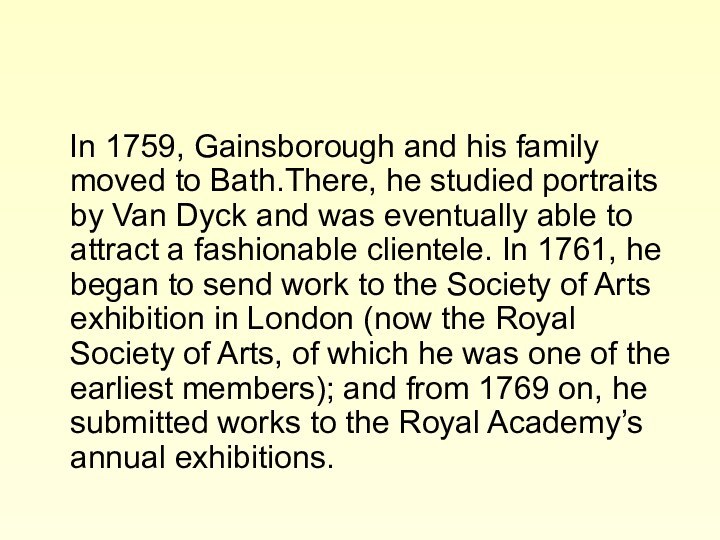- Главная
- Разное
- Бизнес и предпринимательство
- Образование
- Развлечения
- Государство
- Спорт
- Графика
- Культурология
- Еда и кулинария
- Лингвистика
- Религиоведение
- Черчение
- Физкультура
- ИЗО
- Психология
- Социология
- Английский язык
- Астрономия
- Алгебра
- Биология
- География
- Геометрия
- Детские презентации
- Информатика
- История
- Литература
- Маркетинг
- Математика
- Медицина
- Менеджмент
- Музыка
- МХК
- Немецкий язык
- ОБЖ
- Обществознание
- Окружающий мир
- Педагогика
- Русский язык
- Технология
- Физика
- Философия
- Химия
- Шаблоны, картинки для презентаций
- Экология
- Экономика
- Юриспруденция
Что такое findslide.org?
FindSlide.org - это сайт презентаций, докладов, шаблонов в формате PowerPoint.
Обратная связь
Email: Нажмите что бы посмотреть
Презентация на тему Thomas Gainsborough(1727-1788)an English portrait and landscape painter.
Содержание
- 3. Life and Work Thomas Gainsborough
- 4. In 1759, Gainsborough and his
- 5. He selected portraits of well-known
- 6. Portrait of John Needham, 10th
- 7. In 1774, Gainsborough and his
- 8. The Blue Boy
- 9. Her Grace Georgiana Cavendish,
- 10. In his later years, Gainsborough
- 11. River Landscape (1768–1770)
- 12. The Harvest Wagon (c. 1767)
- 13. TechniqueGainsborough was noted for the speed with
- 14. Скачать презентацию
- 15. Похожие презентации
Life and Work Thomas Gainsborough was born in Sudbury Suffolk, the youngest son of John Gainsborough, a weaver and maker of woolen goods, and the sister of the Reverend Humphry Burroughs. At the age














Слайд 4
In 1759, Gainsborough and his family
moved to Bath.There, he studied portraits by Van Dyck
and was eventually able to attract a fashionable clientele. In 1761, he began to send work to the Society of Arts exhibition in London (now the Royal Society of Arts, of which he was one of the earliest members); and from 1769 on, he submitted works to the Royal Academy’s annual exhibitions.
Слайд 5
He selected portraits of well-known or
notorious clients in order to attract attention. These exhibitions
helped him acquire a national reputation, and he was invited to become one of the founding members of the Royal Academy in 1769. His relationship with the academy, however, was not an easy one and he stopped exhibiting his paintings there in 1773.Слайд 6 Portrait of John Needham, 10th Viscount Kilmorey,
(c. 1768) Portrait of the Composer
Carl Friedrich Abel with his Viola da Gamba (c. 1765)
Слайд 7
In 1774, Gainsborough and his family
moved to London. In 1777, he again began to
exhibit his paintings at the Royal Academy, including portraits of contemporary celebrities, such as the Duke and Duchess of Cumberland. Exhibitions of his work continued for the next six years.In 1780, he painted the portraits of King George III and his queen and afterwards received many royal commissions. This gave him some influence with the Academy and allowed him to dictate the manner in which he wished his work to be exhibited. However, in 1783, he removed his paintings from the forthcoming exhibition and transferred them to Schomberg House.
Слайд 9
Her Grace Georgiana Cavendish,
Her
Grace Georgiana CavendishDuchess of Deonshire (1783) (1787)
Слайд 10
In his later years, Gainsborough often
painted relatively simple, ordinary landscapes. With Richard Wilson, he
was one of the originators of the eighteenth-century British landscape school; though simultaneously, in conjunction with Sir Joshua Reynolds, he was the dominant British portraitist of the second half of the 18th century.He died of cancer on 2 August 1788 at the age of 61.





























